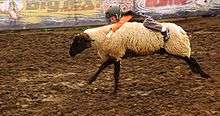Washington State Fair
The Washington State Fair, formerly the Puyallup Fair, is the largest single attraction held annually in the state of Washington. The fair, which includes agricultural and pastoral displays and shows, amusement rides, and a concert series, continually ranks in the top ten largest fairs in the United States.[1] The Washington State Fair hosts two annual events: the 21-day Washington State Fair every September, and the four-day Washington State Spring Fair every April.
| Washington State Fair | |
|---|---|
 | |
| Genre | State fair |
| Dates | Main fair in September, Spring fair in April |
| Location(s) | 110 9th Ave SW Puyallup, Washington 98371 |
| Attendance | 1,065,208 (2010) |
| Website | http://www.thefair.com |
Situated in Puyallup, 35 miles (56 km) south of Seattle and 10 miles (16 km) east of Tacoma near Mount Rainier, the fairgrounds comprise 160 acres (0.65 km2), with buildings and land valued at more than $54 million. The facilities are available for rent throughout the year, making the grounds a valuable community resource. It offers various seasonal festivals, such as the Victorian Country Christmas, as well as races, concerts, car shows, and sporting expositions, such as the International Sportsman's Exposition. A staff of 55 works year-round. Over 7,500 employees are hired each September during the Fair.[2]
History
The first "Puyallup Valley Fair" was held October 4–6, 1900. In 1913, it was renamed "The Western Washington Fair." In 2006, the name was changed to "The Puyallup Fair," which is what many local people still call it. At that time, the venue became known as "The Puyallup Fair and Events Center."[3] Starting in 2013, the fair was renamed the "Washington State Fair." The marketing tagline "Do the Puyallup" was retained.[4]
During World War II, the fair did not take place. The fairgrounds closed after the 1941 fair and were occupied by the army, which set up Camp Harmony, a temporary assembly center within the system of internment camps for Japanese Americans. A total of 7,390 Japanese Americans from the Seattle-Tacoma area and Alaska were confined in converted horse stables and barracks constructed on adjacent parking lots, the racing track and under the grandstand.[5][6] In September 1942, the Japanese Americans were sent to other locations and the camp was torn down. The fairgrounds were briefly occupied by the U.S. Army 943rd Signal Service Battalion until they were transferred to Fort Lewis, then closed until 1946, when the fair set an attendance record of 100,000 people on opening day.[3]
Attendance

Attendance has grown significantly since the fair's October 4, 1900 opening, drawing more than one million people each year. Selected dates:
2012: 1,117,323[7]
2011: 1,059,182[8]
2010: 1,065,208[9]
2009: 1,183,035[10]
2008: 1,163,969[11]
2007: 1,182,937[11]
2006: 1,131,276[11]
2005: 1,117,707[11]
2004: 1,073,581[11]
2003: About 1,160,000[2]
2002: About 1,180,000[2]
2000: About 1,300,000[12]
1993: 1,420,037 (highest attendance ever)[11]
1991: 1,414,487[12]
1989: About 1,300,000[12]
1980-1988: Between 1,100,000 and 1,200,000[12]
Late 1930s: About 400,000[12]
1922: About 130,000[12]
1900: About 5,500 families[12]
See also
Related nearby agricultural fairs
- Pacific National Exhibition in Vancouver, BC whose grounds were also a Japanese Internment Center during World War II
- Evergreen State Fair in nearby Snohomish County, which has around a third of the size and attendance of the Washington State Fair
References
- "Historical Facts: 1900-2000". TheFair.com.
- "Puyallup Fair attendance down slightly". Puget Sound Business Journal. 2003-09-22. Retrieved 2008-09-23.
- "About the Fair". Retrieved 2019-08-31.
- Trujillo, Joshua (2012-09-20). "Puyallup Fair getting a new name". SeattlePI.com. Retrieved 2012-09-23.
- Fiset, Louis. "Puyallup (detention facility)" Densho Encyclopedia. Retrieved 2014-06-19.
- Burton, J., et al (National Park Service, 2000). Confinement and Ethnicity: An Overview of World War II Japanese American Relocation Sites, "Puyallup Assembly Center, Washington." Retrieved 2014-06-19.
- "Puyallup Fair Attendance Tops 1.1 Million Beats Last Year". 2012-09-24. Retrieved 2012-10-02.
- "Puyallup Fair draws just over one-million visitors". 2011-09-25. Retrieved 2011-09-25.
- Schilling, Sara (2010-09-28). "Rain, economy cut into Puyallup Fair numbers". The News Tribune. Retrieved 2010-10-08.
- Santos, Melissa (2009-09-28). "Final Puyallup Fair attendance". The News Tribune. Retrieved 2009-09-28.
- Santos, Melissa (2008-09-23). "Despite nice weather, fewer do the Puyallup". The News Tribune. Retrieved 2008-09-23.
- "Washington State Fair History". thefair.com. Retrieved 2015-09-24.
External links
| Wikimedia Commons has media related to Puyallup Fair. |

